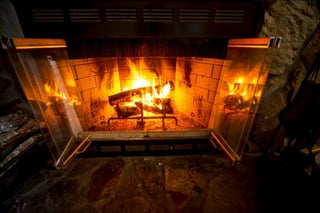How to Reduce Fireplace Heat Loss for Efficient Home Heating
[fa icon="calendar"] November 25, 2015 / by Home Services Expert
 Like many people with a wood-burning fireplace, you might have mixed feelings about this classic slice of Americana.
Like many people with a wood-burning fireplace, you might have mixed feelings about this classic slice of Americana.
Even when it's dormant, it can be a grand, architectural focal point, providing a frame for treasured family photos and keepsakes. And nothing can match the thrill of setting a mass of wood logs aflame, for a fireplace can quickly invigorate a room with warmth, comfort and romanticism.
But as Experts In Your Home pointed out in “Common mistakes people make when heating their home,” a fireplace's come-hither looks belie a cold reality: about 90 percent of the warm air it generates goes right out the chimney while cold air from the open flue comes rushing inside. Put another way, most wood-burning fireplaces are, at best, only 10 percent efficient at converting wood to energy. This can present a home heating challenge.
If you expect nothing more than visual appeal from your fireplace, or you don't burn wood in it anyway, you might wish to plug and seal the chimney flue. There are no shortage of ideas for converting the interior into another type of focal point, the most popular being a place to stage a panoramic display of pillar candles of various sizes.
But if you're determined to keep your home fires burning, some tips from the U.S. Department of Energy can help stem the heat loss from your wood-burning fireplace and make your home heating more efficient:
Take proactive measures
- Apply heat-resistant caulk around the fireplace hearth.
- Ensure that the seal on the fireplace damper, when closed, is snug and secure. If you can't tell, call Experts In Your Home and we'll inspect it for you.
- Adjust the size of the damper opening to the size of the fire you plan to build: a narrow opening for a small fire and a wide opening for a large one. With a flashlight in (your) hand, Experts In Your Home can help you get a good feel for your fireplace damper.
- Before opening the fireplace damper to light a fire, counteract the fireplace's quest to pull cold air into your home through small gaps, windows and doors by closing the doors that lead into the room and opening the window located closest to the fireplace by about 1 inch.
- Lower your thermostat setting to between 50 and 55 degrees while the fireplace burns wood.
Accessorize your fireplace with care
Three accessories will “modestly improve” the home heating efficiency of your wood-burning fireplace, the department of energy says. But only a fireplace insert will make a “significant difference.”
- A fireplace insert, fueled by wood, pellets or gas, seals off heat loss and radiates heat into a room – sometimes improving a fireplace's heating capability by 60 percent or more. Double- and single-wall units are available, with double-wall models being more energy efficient. Optional air-circulating fans can significantly improve heat distribution. Inserts may extend onto the hearth or remain flush with the front of the fireplace. Inserts with decorative accents such as glass doors, handles, enameled fronts, tile or cast iron can accentuate the beauty of a wood-burning fireplace.
- A heat exchanger, made of large tubes and fans, blows warm air from a fireplace back into a room. It can bolster a fireplace's heating ability by about 10 percent, but it requires frequent cleaning (think of all the soot buildup) to remain viable.
- A glass door can reduce heat loss, depending on how it's used. For this assessment, three hands would come in handy. On one hand, burning a fire with the door open is like not having a door at all. On the other hand, closing the door “during the burn” allows you to better control the fire but also reduces the amount of heat that flows into the room. On the last hand, a closed glass door can block downdrafts from the chimney.
Clearly, there is no “one-size-fits-all” solution for everyone who wants to make the most of a wood-burning fireplace. Call our home experts and let us help find the one that's best suited to you – and your slice of Americana.
For more on efficient home heating, download our free offer below:



